As the winter rains recharge groundwater, refill seasonal ponds and wetlands and provide wildlife with vital drinking water, the wet weather brings about another ecological phenomenon, the proliferation of fungi.
While our preserves boast a stunning variety of fungi, it's important to remember that some species are deadly. To ensure your safety and the preservation of these unique organisms, please refrain from picking or consuming any mushrooms you encounter.
These often-overlooked organisms play a crucial role in the health and vitality of our local ecosystems. While you might spot a colorful mushroom on a hike, what you see is just the "fruiting body" – the equivalent of a plant's flower or fruit. The real magic happens underground, with a vast network of thread-like structures called mycelium. Fungi perform essential services that keep our preserves thriving.
Nature's Recyclers
Fungi, along with bacteria, are primary decomposers in our preserves, breaking down everything from fallen leaves and branches to dead animals and even animal waste.
Fungi secrete powerful enzymes that can break down tough materials like wood (cellulose and lignin) and insect exoskeletons (chitin), turning them into usable nutrients.
Without these decomposers, nutrients would be locked up in dead organic matter, making them unavailable for new plant growth.
Partnerships with Plants (Mycorrhizae)
Many plants in our preserves rely on mycorrhizal fungi, which form symbiotic relationships with their roots.
Mycelium acts like an extension of the plant's root system, dramatically increasing its ability to absorb water and essential nutrients like phosphorus and nitrogen. In return, the plants provide the fungi with sugars produced through photosynthesis, creating a symbiotic relationship.
While exploring our Midpen preserves, you might encounter some of these fascinating fungi:
Honey Mushroom (Armillaria ostoyae)
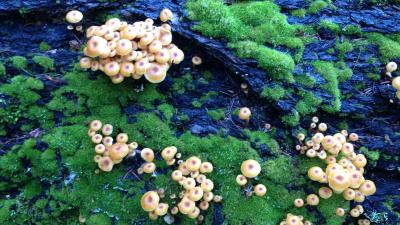
This fungus is known for its extensive underground mycelial network. The mycelium of one individual in Oregon's Malheur National Forest is considered the largest known organism on Earth, covering over 2,384 acres (larger than the entirety of Rancho San Antonio!). The fruiting bodies (mushrooms) themselves are typically honey-colored and grow in clusters at the base of trees or on decaying wood.
Turkey Tail (Trametes versicolor):
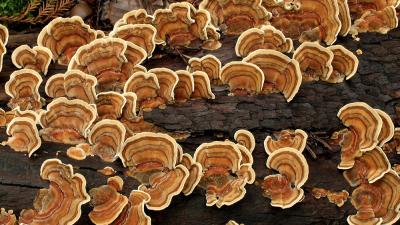
This common bracket fungus is easily recognized by its fan-like shape and concentric bands of various colors, resembling the tail of a turkey. It grows on dead logs and branches, playing a vital role in wood decomposition. The underside is covered in tiny pores, a key characteristic that distinguishes it from similar-looking fungi. It is the mushroom with the highest number of iNaturalist observations in the Bay Area.
The Death Cap (Amanita phalloides)
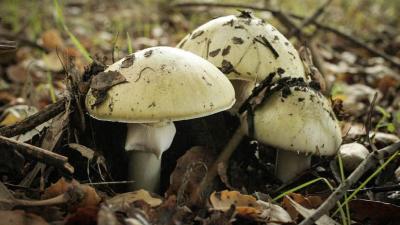
The death cap mushroom, a beautiful but deadly species, is responsible for most fatal mushroom poisonings globally. This invasive fungus, often found near oak trees, can be identified by its greenish-gray cap, white gills, and a distinctive white sac at the base of its stem. It typically emerges in late fall after the first rains.
Waxy Caps (Hygrocybe sp.):

These brightly colored mushrooms (ranging from red and orange to yellow and even green) are named for their waxy-textured gills. They are often found in grassy areas, woodlands and mossy areas. The vibrant colors serve as a warning to potential predators, as some species are mildly toxic.
Bird's Nest Fungus (family Nidulariaceae):
These small fungi resemble miniature bird's nests, complete with tiny "eggs" inside. The "eggs" are actually peridioles, containing spores. When raindrops fall into the cup-shaped structure, the peridioles are ejected, dispersing the spores, allowing for the fungus to reproduce. They are commonly found on wood chips, mulch, and other decaying plant matter. Check out the video from KQED about the bird's nest fungus.
Purple Crust Fungus (Punctularia atropurpurascens):
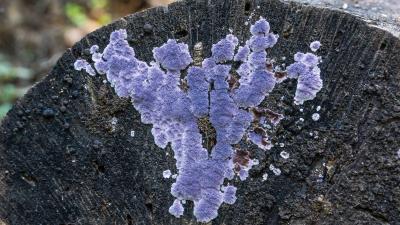
This fungus forms a striking purple crust on decaying hardwood logs, particularly oak. The surface has a slightly fuzzy or velvety texture, especially at the edges. It plays a role in breaking down deadwood and recycling nutrients.
Lion's Mane (Hericium erinaceous):
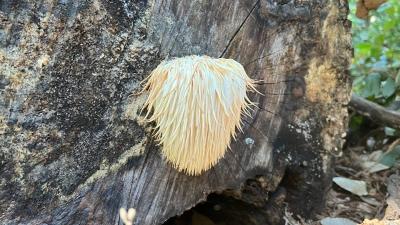
This distinctive fungus resembles a white or cream-colored pom-pom or a lion's mane, with long, shaggy spines hanging down. It grows on dead or dying hardwood trees, particularly oak. It is edible and has gained attention for its potential medicinal properties, although it's important not to harvest it from any Midpen preserve.
Eyelash Cup Fungi (Scutellinia group):
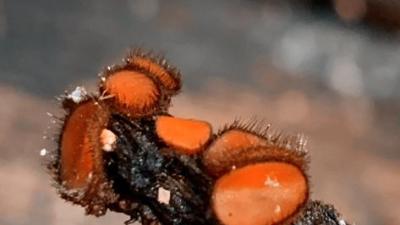
These tiny, bright orange cup fungi are named for the fine, hair-like "eyelashes" that fringe the rim of the cup. They are typically only a few millimeters in diameter and are found in damp areas on decaying wood or in damp soil. They are widespread and can decompose a variety of wood types, including eucalyptus.
Important Reminder: Collecting mushrooms in Midpen preserves is strictly prohibited.
While exploring our preserves, we encourage you to observe and appreciate these amazing organisms. However, do not collect or consume any wild mushrooms. Some species are poisonous and removing them disrupts the natural ecosystem. Let's admire their beauty from afar and leave them to perform their essential role in the intricate web of life.

